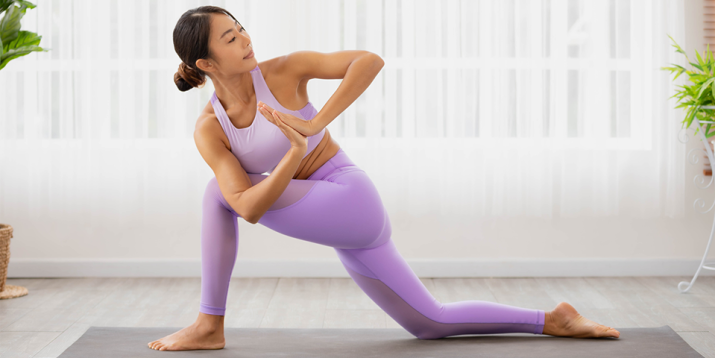What’s the Difference Between Mobility and Flexibility?

You know every good workout routine requires a healthy combination of cardio, strength training, and when you’re feeling extra, some high-intensity interval training.
But if you perform exercises from any of these types of workouts using faulty movement patterns and improper form, injury is going to result.
The antidote: mobility.
What Is Mobility?
“Mobility is the ability of a joint to move freely through its full range of motion without pain or compensation,” says Cody Braun, CSCS.
He explains that mobility is something you probably had plenty of as a kid — but slowly lost due to things like 9-to-5 work, muscle compensations, and faulty movement patterns — and it’s one indicator of how well and freely you move.
Shoulder mobility

To understand why mobility is so important, think about your shoulder joint.
Shaped like a ball and socket, the shoulder is designed so you can move your arm backward, forward, side-to-side, and in circles.
If it moves like it should, the joint enjoys healthy mobility.
If, however, certain movements such as transferring your laundry from the washer to the dryer, tossing a ball for your dog, or bringing your upper arm beside your ear are impossible or cause pain, you may have a lack of shoulder mobility on your hands.
“If you’re trying to raise your arm or press weight overhead but can’t get your arms in position, your body will try to compensate by arching your back and shrugging your shoulders, which can cause other issues and injury,” Braun says.
Lack of mobility in the shoulder joint may contribute to the fact that, according to one review published in The Journal of Strength and Conditioning Research, shoulder injuries comprise a whopping 36 percent of strength-training injuries.
Hip mobility

When it comes to mobility (or a lack thereof) another common problem area is the hips.
The muscles that connect to the pelvis can become tight due to anything from cycling to excessive binge watching.
Problem is, when the hip muscles tighten, a chain reaction results and the surrounding structures can be adversely affected.
One study, published in the International Journal of Sports Physical Therapy, found that when athletes with tight hip muscles performed a squat, they suffered decreased muscle activation in their hip extensors (like the glutes).
As a result, compensation can occur. “Compensatory movements are inefficient, and often cause problems or injury in other areas of the body,” Braun says.
That’s why he says mobility is essential to our overall quality of life, especially as we get older.
Because our ability to move without restriction or pain means that we can comfortably perform daily activities.
Mobility vs. Flexibility: What’s the Difference?
While, colloquially, “mobility” and “flexibility” may seem the same, they’re not actually synonymous.
Simply put, mobility refers to the movability of a joint, while flexibility refers to the elasticity of a muscle.
“There is some overlap, as they both impact each other,” Braun says. “For instance, if muscles are tight (inflexibility), you won’t be able to take the joint through its full range of motion (immobility). On the other hand, if your body recognizes that you don’t have the ability or strength to stabilize a joint at its end range of motion, your body will limit that movement by reducing flexibility.”
To be clear, you can be flexible yet not have complete overall mobility, and you can also be mobile without being particularly flexible.
In general, flexibility falls under the larger umbrella of mobility, and for optimal health and performance you should emphasize both.
How Can You Improve Joint Mobility?

Stretching and foam rolling form one part of the mobility equation, but they don’t solve everything.
Interestingly, research shows that strength training — especially the eccentric, or lengthening, phase of a movement under load — is actually a great way to improve flexibility and mobility.
In fact, in one North American Journal of Sports Physical Therapy study of young athletes with tight hamstrings, those who did eccentric hamstring exercises increased their flexibility twofold over those who performed static (bend-and-hold) stretches.
The key to improving mobility through strength training is to move through your entire range of motion with control during each rep, Braun says.
With practice, that range of motion will expand.
He explains that strength-training exercises can also help shore up muscle imbalances and strengthen muscles that are required to help their corresponding joints move properly.
Strength training can include activities such as yoga, bodyweight moves like push-ups, and at-home exercises with dumbbells and resistance bands.
Benefits of Mobility Training
Mobility is often an overlooked component of fitness, but with all of these advantages it’s hard to understand why.
1. Reduced risk of injury
You’re best able to perform exercises with safe and proper form when each joint can move through a healthy range of motion.
2. Improved performance
When your body works as designed, it operates not only safer, but also more efficiently. That eliminates “leaks” of wasted energy, allowing you to do more work, better.
3. Better fitness results
Improved performance yields improved results, whether your goal is fat loss, muscle gain, or heightened endurance.
4. Less pain
Whether you’re doing workouts or day-to-day tasks, healthy mobility reduces wear and tear on joints, as well as any muscle compensations that could lead to overuse aches and injuries.
5. Improved quality of life
Mobility is paramount to performing everyday tasks such as putting away groceries, playing with your kids, and climbing a flight of stairs.
By improving day-to-day performance as well as reducing any pain associated with it, mobility helps you live your fullest life.
